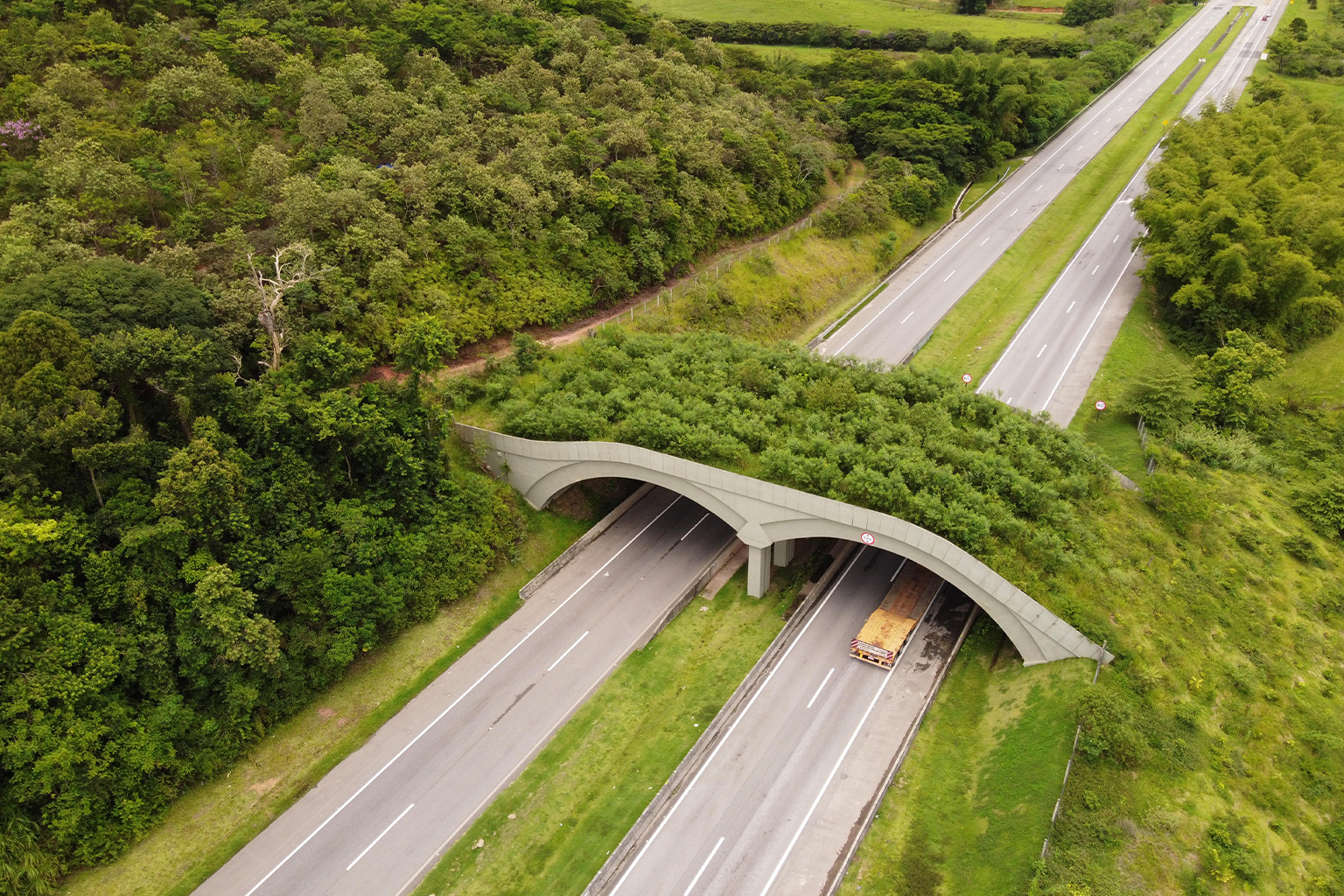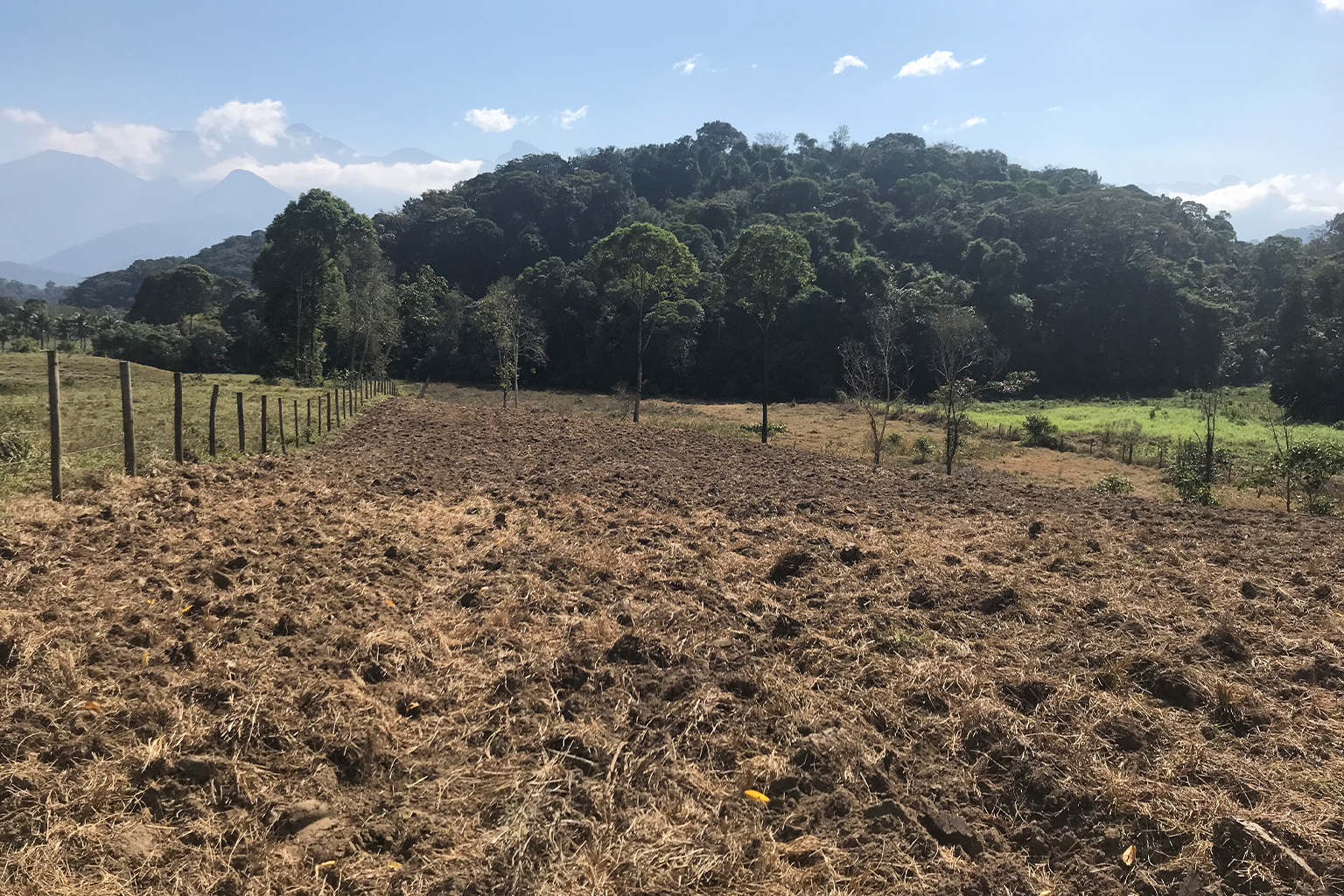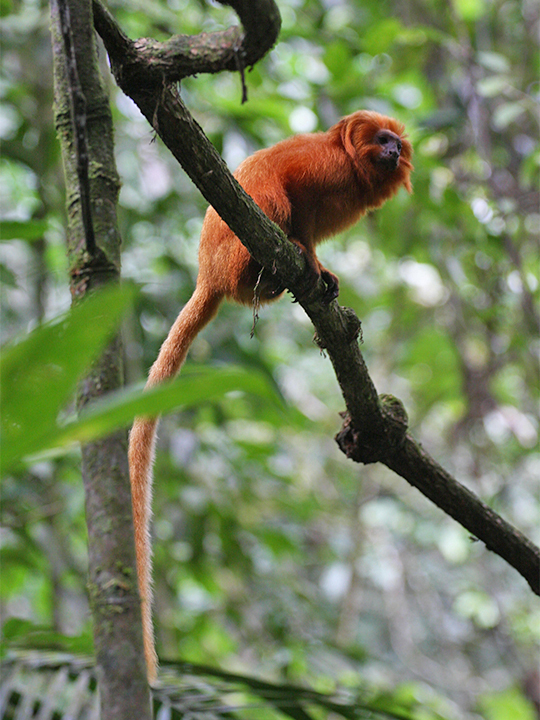- This three-part Mongabay mini-series examines grassroots forest restoration projects carried out within isolated island ecosystems — whether those islands are surrounded by ocean as on the Big Island of Hawai‘i, or cloud forest mountaintop habitat encircled by lowlands in Costa Rica, or forest patches hemmed in by human development in Brazil.
- Reforestation of degraded island habitat is a first step toward restoring biodiversity made rare by isolation, and to mitigating climate threats. Though limited in size, island habitats can be prime candidates for reforestation because extinctions are typically much higher on isolated habitat islands than in more extensive ecosystems.
- Scientists mostly agree that the larger the forest island habitat, the greater its biodiversity, and the more resilient that forest system will be against climate change. Forests also store more carbon than degraded lands, and add moisture to soil and the atmosphere as a hedge against warming-intensified drought.
- The projects featured in this series are small in size, but if scaled up could become big forest nature-based climate solutions. In this third story, the NGO Saving Nature works to create wild corridors to reconnect fragmented patches of Brazil’s Atlantic Forest.
This story is the third article of a three-part Mongabay mini-series on island habitat forest restoration projects. Read Part One and Part Two.
More and more, the world’s isolated and beleaguered island habitats aren’t in the sea or even atop mountains: they’re islands of biodiversity surrounded by human communities. And few biomes on Earth are more fragmented than the Atlantic Forest of Brazil, or the Mata Atlântica. Once stretching unbroken from central Brazil to Argentina, this coastal rainforest was fractured over centuries by logging, agriculture and urban sprawl. Around 7% of the Atlantic Forest remains today, most of that in fragments of various sizes, out of a once estimated 133 million hectares (329 million acres).
But there is hope for what’s left, if some of the many island habitat fragments can be reconnected and enlarged.
That’s the mission of Saving Nature, an NGO that began regrowing its first forest corridor linking up isolated patches of Atlantic Forest habitat in 2007. The project, dubbed Fazenda Dourada (“Golden Farm” in Portuguese), was selected to help support one of the region’s flagships species, the endangered golden lion tamarin (Leontopithecus rosalia).
“You create forest fragments and they lose species. And the smaller they are, the more they lose,” explains conservation scientist Stuart Pimm, who founded Saving Nature, which was called Saving Species up until 2019. The NGO has over the years created 14 corridor and forest protection projects in six countries, with efforts underway in South America, Asia and Africa.

Restoring forest islands amid a human sea
Pimm, a professor of conservation ecology at Duke University and one of the world’s foremost conservation biologists, first saw the principles of island biogeography at work when helping conduct research on islands off the British coast and in the Brazilian Amazon — the latter being a scientifically groundbreaking initiative launched by renowned ecologist Tom Lovejoy dubbed the Biological Dynamics of Forest Fragments Project (BDFFP), which has cataloged losses to rainforest patches for decades.
Island biogeography, or insular biogeography, a field created in the 1960s by ecologist Robert H. MacArthur and biologist E.O. Wilson, and greatly advanced by Lovejoy, defines an insular environment as an area of habitat suitable to a particular ecosystem, but surrounded by unsuitable habitat. These “habitat islands” were initially recognized as terrestrial islands isolated by the ocean, like those in the Hawaiian archipelago; but also exist today as alpine summits isolated by escalating climate change, in places like the cloud forests of Costa Rica; or hemmed in by human development, like the habitat fragments found in Brazil’s Atlantic Forest biome.
The bad news, as Pimm learned early on, is that the smaller an island habitat becomes, the fewer species can occupy it, and the shallower their gene pool, making adaption to change increasingly difficult. This narrowing biodiversity bottleneck makes extinctions far more likely, a dynamic defined by island biogeographers as the species-area relationship.
But here’s the good news: Conversely, the bigger an island habitat gets, the more resilient it becomes — thus the extraordinary value of wild corridors that reestablish habitat connectivity, allowing species to roam between habitat islands.
“It became pretty obvious to me that when you look at the kinds of landscapes that dominate in the world’s [biodiversity] hotspots, they’re nearly all fragmented … That’s really true of the [Atlantic Forest] because [Brazil’s] Forest Code requires people to leave a certain amount of their land in forests. So, what you typically see is hilltops [covered in] trees and everything else has been cleared,” Pimm says. “What are we going to do to slow the extinction rate? Quite clearly, we need to reconnect.”

Traveling in Brazil in 2006, Pimm came upon the União Biological Reserve, a federal wildlife conservation area in Rio de Janeiro state, located deep within the human landscape of the heavily fragmented Atlantic Forest biome.
“It was 2,500 hectares [nearly 6,200 acres] and it was isolated … by a huge cattle pasture from upslope forests,” he recalls. So, he asked the question: “‘How much is it going to cost to buy the cattle pasture and reforest it?’ The answer was $300,000.”
With this goal in mind, Pimm founded Saving Species (now Saving Nature) and within a few years raised the money for a 100-hectare (250-acre) corridor. He gave the money to a local partner NGO, the Golden Lion Tamarin Association; they purchased the land for reforestation and handed it over to the União Biological Reserve.
“Fast forward 15 years: That’s a lovely forest. The satellite images are really quite impressive. It’s completely connected,” Pimm says. “The [reserve] is no longer isolated … We found the [wild] species came back, moving through the corridors an awful lot faster than we [expected]. I thought this was something I would have to live to be 100 to see, but the reality is it’s the tropics: It’s warm and wet and the trees grow fast.”
The ball continued rolling. After the corridor was handed over to reserve officials, they obtained a conservation easement. Today, the area’s protected habitat includes 20,000 hectares (49,400 acres) of contiguous forest, all under some kind of conservation management — an increase of almost 10 times the original fragment. And the larger that habitat grows, the more wild species thrive there.
“The only thing we need to do now is more of the same,” says Pimm, upon considering the success at the União Biological Reserve.


Connecting the world’s wild dots
Next, in 2018, the team turned to the Poço das Antas Biological Reserve — the “Place of the Tapirs,” though the large herbivore had long been extirpated there.
This important federal reserve had been created in the Atlantic Forest biome in 1974 specifically to protect the lion tamarin and maned sloth (Bradypus torquatus). But at the reserve’s north edge, a widening of the coastal highway BR-101 was about to make it impossible for animals to cross from the reserve on one side of the busy road to habitat on the other.
To rectify this, the Brazilian government required the building of a green overpass so animals could cross the four-lane highway — the first ever such wildlife bridge in Brazil. The only problem? There was still a gap of pastureland between the two forest fragments.
Saving Nature went to work with local partner the Golden Lion Tamarin Association, to link the reserve via the green bridge to the newly purchased but degraded agricultural lands and fragmented forests of the Igarapé Farm. Reforestation there is ongoing.

Currently, Saving Nature is working to raise $2 million for its third Atlantic Forest project in collaboration with well-established local conservation NGO Reserva Ecologica de Guapiaçu (REGUA). The partners plan to create a 522-hectare (1,290-acre) corridor protecting wildlife as well as a vital watershed for the city of Rio de Janeiro.
“We get a lot of bang for our buck. Our partners haven’t bought huge amounts of land, but they have reconnected spectacular amounts of land,” Pimm says.
Although largely purchased with biodiversity in mind, these reforested corridors will also have positive climate impacts. Research has shown that larger, more biodiverse ecosystems have the capacity for storing more carbon than plantation forests or degraded agricultural lands. Wooded restored corridors also increase ecosystem resilience against climate change by linking and enlarging vulnerable forest fragments. The public can play a role in increasing these climate benefits: Saving Nature has tools to allow anyone to offset airline flights or their overall carbon footprint, in the process generating donations that not only store forest carbon, but protect biodiversity.
As the world heats up, restored Atlantic Forest trees will also provide shade for vulnerable species, and humans, while helping retain soil and atmospheric moisture. Indeed, Saving Nature’s most recent reforestation project is all about preserving a vital urban watershed — all the more important in a warming world where droughts are becoming more intense.

The pragmatic connectivity process
Fragmented forests are everywhere one looks in the human-shaped landscape. So, Saving Nature needs to carefully prioritize where it works to maximize impact. The NGO starts its site selection process by turning to the world’s global biodiversity hotspots, as first defined by ecologist Norman Myers in 1988.
“We’ve upgraded Norman’s ideas by doing better mapping,” says Pimm, adding that “We’ve come up with some very, very sophisticated mapping efforts now, bringing in sensing and crowdsource data, bringing in eBird and iNaturalist … We’ve got really good maps of where we think we want to be.”
The group also considers intensifying climate change impacts, preferring projects with altitudinal shifts, so animals and plants can move higher along a corridor as a region warms. “We know species are moving up. We know what the problem is, and we know what the solution is,” Pimm says. “You’ve got to create corridors that allow species to move upslope.”
Once the NGO selects a project, it gathers aerial data, usually using drones. Next, the team goes to meet with local organizations and people and to walk the land. “You’ve got to get out there, you’ve got to get your feet dirty!” says Pimm.
A number of practical considerations dictate where a corridor will ultimately be situated. “Is [the landowner] going to sell the land? Is it too expensive? Is it in exactly the right places? Probably a dozen different reasons” are considered before a final route is chosen, explains Pimm.

If all goes Saving Nature’s way, they pair up with local groups, and as Pimm says, “let [them] get on with it” — “It” being the on-the-ground conservation and restoration work.
“The idea that we can do conservation sitting inside an air-conditioned building inside the Washington, D.C. beltway, I think is rubbish. What we wanted to do was empower local groups,” Pimm says. Saving Nature carefully vets well-respected local conservation organizations before handing over project money to them.
Those local partners handle a project’s nitty-gritty specifics — determining what’s planted, how and where — though Saving Nature does provide research and technical support.
“We want them to plant … trees, but there is a very high degree of local contingency,” Pimm explains. In some Saving Nature projects, such as those in Colombia, the local groups simply need to remove grazing cattle and the native vegetation will come back quickly.
“In Brazil, it’s much more difficult,” he says. Projects there “regularly require a huge amount of preparation of the land, and we have to keep on the [invasive] weeds to make sure they don’t come back. Our partners understand that there are some principles: You put in fast-growing trees first, and they provide shade, then you grow slow-growing trees underneath.”
Replanting isn’t simple. “You can’t just go to a local nursery and say, ‘Could I have 100 species of trees?’” says Pimm. The conservation team often relies on a secret weapon when partnering with local organizations during replanting: “grandmothers.”
When he started working alongside the Golden Lion Tamarin Association, Pimm met Maria da Conceição Coelho, a.k.a. Dona Graça, a Brazilian woman who took over growing seedlings for the project. Pimm estimates she currently has tens of thousands of thriving trees to her credit.
Dona Graça “is amazing because she now knows how to germinate … probably 100 species of tree,” he says. “She’ll explain how she does every one of them [to anyone who wants to learn and play a role]. It takes about half an hour per tree … She’s become entirely self-taught.”

The emphasis is always on getting trees in the ground, Pimm says, not on expensive research. That’s why Saving Nature doesn’t require local groups to continuously survey its corridors. Science costs money, Pimm points out, and Saving Nature would rather spend limited funds on making more corridors rather than on studying the ones already growing.
“If you said, ‘Look, I’ve got $100,000. Do you want to spend it on doing science, or do you want to spend it on buying another corridor?’” Pimm asks, then answers: “I’ll take the other corridor.”
That doesn’t mean the group doesn’t have its eyes on changing corridors: Local groups track wildlife movements via camera traps, mist netting and recorded sightings. But it’s not always done with the purpose of future journal publication.
“What we don’t do is lie awake at night wondering whether there are 10 different ways to do it … We get trees in the ground,” Pimm asserts. The reason being, he says, is that the relationship between habitat fragmentation and extinction is pretty much resolved.
“How many more hundreds of studies do you need on habitat fragmentation?” he asked. “The problem’s there. We know it’s a problem. Let’s connect things together and get things working again.”
Banner image: The endangered golden lion tamarin (Leontopithecus rosalia). Image by Martin Fisch via Flickr (CC BY 2.0).
FEEDBACK: Use this form to send a message to the author of this post. If you want to post a public comment, you can do that at the bottom of the page.
Read Part One:
From ukuleles to reforestation: Regrowing a tropical forest in Hawai‘i
Citations:
Hanski, I., Zurita, G. A., Bellocq, M. I., & Rybicki, J. (2013). Species–fragmented area relationship. Proceedings of the National Academy of Sciences, 110(31), 12715-12720. doi:10.1073/pnas.1311491110
Chen, S., Wang, W., Xu, W., Wang, Y., Wan, H., Chen, D., … Bai, Y. (2018). Plant diversity enhances productivity and soil carbon storage. Proceedings of the National Academy of Sciences, 115(16), 4027-4032. doi:10.1073/pnas.1700298114
Myers, N., Mittermeier, R. A., Mittermeier, C. G., Da Fonseca, G. A., & Kent, J. (2000). Biodiversity hotspots for conservation priorities. Nature, 403(6772), 853-858. doi:10.1038/35002501
